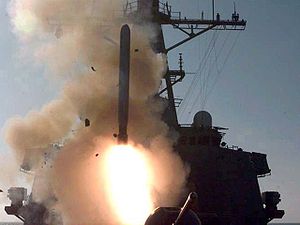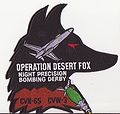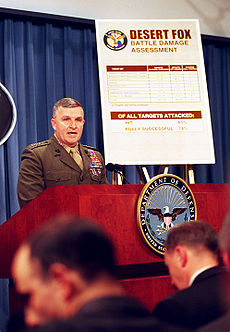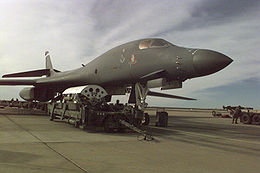- Bombing of Iraq (December 1998)
-
Operation Desert Fox Part of Iraqi no-fly zones 
A Tomahawk cruise missile (TLAM) is fired from an
Arleigh Burke-class destroyer during Desert FoxDate December 16–19, 1998 Location Persian Gulf Result Ceasefire; much of Iraqi infrastructure destroyed. Belligerents  United States
United States
 United Kingdom
United Kingdom Iraq
IraqCommanders and leaders  Anthony Zinni
Anthony Zinni Saddam Hussein
Saddam HusseinStrength 30,500 Unknown Casualties and losses None 600-2,000 dead [1] Recent wars and conflicts
in the Persian Gulf- Iran-Iraq War
- Opera
- Gulf War
- 1991 uprisings
- Provide Comfort
- Southern Watch
- 1993 cruise missile strikes
- Iraqi Kurdish Civil War
- Desert Strike
- Northern Watch
- Desert Fox
- Kurdistan Islamist Conflict
- Southern Focus
- Iraq War
- 2011 Bahraini protests
The December 1998 bombing of Iraq (code-named Operation Desert Fox) was a major four-day bombing campaign on Iraqi targets from December 16–19, 1998 by the United States and United Kingdom. The contemporaneous justification for the strikes was Iraq's failure to comply with United Nations Security Council resolutions as well as their interference with United Nations Special Commission inspectors. Although many believe that the operation was named for German Field Marshal Erwin Rommel, who earned the nickname "Desert Fox" during the North African Campaign of World War II, this was not the case; the operational name was one of at least a half dozen contingency plans that U.S. Central Command developed to respond to a range of possible crises involving Iraq. Others included "Desert Lion," "Desert Badger," "Desert Viper," and "Desert Raptor" and were not used in order to mitigate an offensive perception of the operation, although the reference to Rommel was not thought of beforehand.[citation needed]
It was a major flare-up in the Iraq disarmament crisis. The stated goal of the cruise missile and bombing attacks was to strike military and security targets in Iraq that contribute to Iraq's ability to produce, store, maintain and deliver weapons of mass destruction.
On October 31, 1998 US President Bill Clinton had signed into law H.R. 4655, the Iraq Liberation Act.[2] The new Act appropriated funds for Iraqi opposition groups in the hope of removing Saddam Hussein from power and replacing his regime with a democracy.The Act also said that:
Nothing in this Act shall be construed to authorize or otherwise speak to the use of United States Armed Forces (except as provided in section 4(a)(2)) in carrying out this Act.
Section 4(a)(2) states:
The President is authorized to direct the drawdown of defense articles from the stocks of the Department of Defense, defense services of the Department of Defense, and military education and training for [Iraqi democratic opposition] organizations.
The bombing campaign had been anticipated since February 1998 and incurred wide-ranging criticism and support, at home and abroad.[3] Saudi Arabia, Bahrain and the United Arab Emirates initially announced they would deny US military the use of local bases for the purpose of air strikes against Iraq.[4] It became one of the roots of the 2003 invasion of Iraq when Saddam Hussein was removed from power.
Contents
"Degrading", not eliminating
Clinton administration officials said the aim of the mission was to "degrade" Iraq's ability to manufacture and use weapons of mass destruction, not to eliminate it. Secretary of State Madeleine Albright was asked about the distinction while the operation was going on:[5]
- "I don't think we're pretending that we can get everything, so this is - I think - we are being very honest about what our ability is. We are lessening, degrading his ability to use this. The weapons of mass destruction are the threat of the future. I think the president explained very clearly to the American people that this is the threat of the 21st century. [. . .] [W]hat it means is that we know we can't get everything, but degrading is the right word."
The main targets of the bombing included weapons research and development installations, air defense systems, weapon and supply depots, and the barracks and command headquarters of Saddam's elite Republican Guard. Also, one of Saddam's lavish presidential palaces came under attack. Iraqi anti-air batteries, unable to hone in on the American and British jets, began to blanket the sky with near random bursts of flak fire. The air strikes continued unabated however, and cruise missile barrages launched by naval vessels added to the bombs dropped by the planes. By the fourth night, most of the specified targets had been damaged or destroyed and the Operation was deemed a success. U.S. Special Forces members who had been on the ground in northern Iraq to protect Kurdish settlements from retaliation withdrew, and the air strikes ended.
Military operations
 Desert Fox patch from Navy Carrier Air Wing 3
Desert Fox patch from Navy Carrier Air Wing 3
U.S. Navy aircraft from Carrier Air Wing Three (CVW 3), flying from USS Enterprise (CVN-65), Carrier Air Wing Eleven (CVW 11), flying from USS Carl Vinson (CVN-70), and Patrol Squadron Four (PATRON FOUR), flew combat missions from the Persian Gulf in support of ODF. Of significance, the operation marked the first time that women flew combat sorties as U.S. Navy strike fighter pilots[6][7] and the first combat use of the B-1B bomber from the 28th Air Expeditionary Group stationed at Thumrait Air Base, Sultanate of Oman. Ground units included the 31st Marine Expeditionary Unit (Special Operations Capable), of which 2nd Battalion 4th Marines served as the ground combat element; based from USS Belleau Wood (LHA-3) Amphibious Ready Group, which included USS Germantown (LSD-42) USS Dubuque (LPD-8). The U.S. Air Force sent several sorties of F-16's from the 34th Fighter Squadron, and 522nd Fighter Squadron into Iraq to fly night missions in support of Operation Desert Fox; they were based at Ahmed Al Jaber Air Base, Kuwait.
The British military contribution to the operation involved Royal Air Force Panavia Tornado strike aircraft.
Reaction
In reaction to the attack, three of five permanent members of the UN Security Council (Russia, France, and the People's Republic of China) called for lifting of the eight-year oil embargo on Iraq, recasting or disbanding UNSCOM, and firing its chairman, Australian diplomat Richard Butler.
Criticism
Accusations of US interference in the UN inspection process
Iraq stopped cooperating with the UN special commission in the first month of the year, but diplomacy by Kofi Annan brought fresh agreement and new modalities for the inspection of sensitive sites.[8] Deputy Prime Minister Tariq Aziz had earlier accused UNSCOM officials of acting as spies for the United States,[9] charges later supported by Scott Ritter and Bill Tierney.[10][11]
According to Ritter, inspectors acted covertly on behalf of the United States to deliberately provoke Iraq into non-compliance, thus providing US war planners with a justification for war.[10] Ritter accused Butler and other UNSCOM staff of working with the US, in opposition to their UN mandate. He claimed that UNSCOM deliberately sabotaged relations with Iraq by insisting on gathering intelligence unrelated to prohibited weapons, some of which was to be used in the forthcoming bombing.[10]
Inspectors not thrown out
The claim that UNSCOM weapons inspectors were expelled by Iraq has been repeated frequently. U.S. Secretary of State Colin Powell, in his February 5, 2003 speech before the U.N. Security Council, called for action against Iraq and stated falsely that "Saddam Hussein forced out the last inspectors in 1998".[citation needed] The claim has appeared repeatedly in the news media.[12] However, according to UNSCOM inspector Richard Butler himself, it was U.S. Ambassador Peter Burleigh, acting on instructions from Washington, who suggested Butler pull his team from Iraq in order to protect them from the forthcoming U.S. and British air strikes: "I received a telephone call from US Ambassador Peter Burleigh inviting me for a private conversation at the US mission... Burleigh informed me that on instructions from Washington it would be 'prudent to take measures to ensure the safety and security of UNSCOM staff presently in Iraq.' ... I told him that I would act on this advice and remove my staff from Iraq."[13]
Facilities not known to be producing WMD
 Gen. Anthony C. Zinni briefs reporters at The Pentagon following Operation Desert Fox, December 21, 1998.
Gen. Anthony C. Zinni briefs reporters at The Pentagon following Operation Desert Fox, December 21, 1998.
Former U.S. Army intelligence analyst William Arkin contended in his Washington Post column January, 1999 that the operation had less to do with WMD and more to do with destabilizing the Iraqi government.
It is clear from the target list, and from extensive communications with almost a dozen officers and analysts knowledgeable about Desert Fox planning, that the U.S.-British bombing campaign was more than a reflexive reaction to Saddam Hussein's refusal to cooperate with UNSCOM's inspectors. The official rationale for Desert Fox may remain the "degrading" of Iraq's ability to produce weapons of mass destruction and the "diminishing" of the Iraqi threat to its neighbours. But careful study of the target list tells another story. Thirty-five of the 100 targets were selected because of their role in Iraq's air defense system, an essential first step in any air war, because damage to those sites paves the way for other forces and minimizes casualties all around. Only 13 targets on the list are facilities associated with chemical and biological weapons or ballistic missiles, and three are southern Republican Guard bases that might be involved in a repeat invasion of Kuwait. The heart of the Desert Fox list (49 of the 100 targets) is the Iraqi regime itself: a half-dozen palace strongholds and their supporting cast of secret police, guard and transport organizations.[14]
According to Department of Defense personnel with whom Arkin spoke, Central Command chief Anthony Zinni insisted that the U.S. only attack biological and chemical sites that "had been identified with a high degree of certainty." And the reason for the low number of targets, said Arkin, was because intelligence specialists "could not identify actual weapons sites with enough specificity to comply with Zinni's directive."
Dr. Brian Jones was the top intelligence analyst on chemical, biological and nuclear weapons at the Ministry of Defence.[15] He told BBC Panorama in 2004 that Defence Intelligence Staff in Whitehall did not have a high degree of confidence any of the facilities identified, targeted and bombed in Operation Desert Fox were active in producing weapons of mass destruction. Jones' testimony is supported by the former Deputy Chief of Defence Intelligence, John Morrison, who informed the same program that, before the operation had ended, DIS came under pressure to validate a prepared statement to be delivered by then Prime Minister Tony Blair, declaring military activity an unqualified success. Large-scale damage assessment takes time, responded Morrison, therefore his department declined to sign up to a premature statement. "After Desert Fox, I actually sent a note round to all the analysts involved congratulating them on standing firm in the face of, in some cases, individual pressure to say things that they knew weren't true". Later on, after careful assessment and consideration, Defence Intelligence Staff determined that the bombing had not been all that effective.[16]
Within days of speaking out on the program, Morrison was informed by former New Labour cabinet minister Ann Taylor that he was to lose his job as Chief Investigator to the Intelligence and Security Committee.[17][18]
The Duelfer Report concluded in 2004 that "Iraq's WMD program was essentially destroyed in 1991 and Saddam ended Iraq's nuclear program after the 1991 Gulf War."
Distraction from Clinton impeachment scandal
Some critics of the Clinton administration expressed concern over the timing of Operation Desert Fox.[19] The four-day bombing campaign occurred at the same time the U.S. House of Representatives was conducting the impeachment hearing of President Clinton. Clinton was impeached on December 19, the last day of the bombing campaign. A few months earlier, similar criticism was levelled during Operation Infinite Reach, wherein missile strikes were ordered against suspected terrorist bases in Sudan and Afghanistan, on August 20. The missile strikes began three days after Clinton was called to testify before a grand jury during the Lewinsky scandal and his subsequent nationally televised address later that evening in which Clinton admitted having an inappropriate relationship.
The Operation Infinite Reach attacks became known as "Monica's War" among TV news people, due to the timing. ABC-TV announced to all stations that there would be a special report following Lewinsky's testimony before Congress, then the special report was pre-empted by the report of the missile attacks. The combination of the timing of that attack and Operation Desert Fox led to accusations of a Wag the Dog situation.
Criticism of the extent of the operation
Other critics, such as former U.S. Secretary of State Henry Kissinger said the attacks did not go far enough: "I would be amazed if a three-day campaign made a decisive difference," Kissinger said just after the operation ended.
[W]e did not do, in my view, enough damage to degrade it [Iraq's programs for weapons of mass destruction] for six months. It doesn't make any significant difference because in six months to a year they will be back to where they are and we cannot keep repeating these attacks. [...] At the end of the day what will be decisive is what the situation in the Middle East will be two to three years from now. If Saddam is still there, if he's rearming, if the sanctions are lifted, we will have lost, no matter what spin we put on it.[20]
While the bombing was ongoing, the Vanguards of Conquest issued a communique to Islamist groups calling for attacks against the United States "for its arrogance" in bombing Iraq.[21]
See also
- Bombing of Iraq (September 1996)
References
- ^ "Twentieth Century Atlas - Death Tolls". users.erols.com. http://users.erols.com/mwhite28/warstat7.htm#Iraq98. Retrieved 2008-10-27.
- ^ Iraq Liberation Act of 1998 The Library of Congress.
- ^ Headlines of February 16, 1998 Democracy Now!
- ^ The Possibility of "Mini-Nukes" On Iraq, Democracy Now!, February 17, 1998
- ^ Public Broadcasting Service (PBS) NewsHour Online Web site (for the NewsHour with Jim Lehrer television program on PBS, Web page containing transcript of television interview and titled "Secretary Albright: December 17, 1998, accessed September 25, 2006
- ^ http://userpages.aug.com/captbarb/fox.html
- ^ http://www.defenselink.mil/transcripts/transcript.aspx?transcriptid=1792
- ^ Annan, Iraq sign weapons-inspection deal CNN, February 23, 1998
- ^ Iraq applauds spy claims BBC News, January 7, 1999
- ^ a b c Ritter, Scott. Iraq Confidential I.B. Tauris. 2005
- ^ Inspector a US spy Daily Mirror, February, 2003
- ^ "There They Go Again: The Washington Post's Iraq Tall Tale". FAIR. http://www.fair.org/index.php?page=1750. Retrieved 2010-09-30.
- ^ Butler, Richard. "Saddam Defiant: The Threat of Weapons of Mass Destruction, and the Crisis of Global Security," Weidenfeld & Nicholson, 2000, p.224
- ^ The Difference Was in the Details The Washington Post, January 17, 1999
- ^ Dr Brian Jones "confused" by Prime Minister's evidence to Hutton, BBC, July 11, 2004
- ^ A failure of intelligence, BBC Panorama, July 9, 2004
- ^ Axed intelligence expert defiant, BBC News, October 28, 2004
- ^ What the Papers say - A failure of intelligence BBC News, August 11, 2004
- ^ Hitchens, Christopher. "No One Left to Lie To" Verso. 1999
- ^ Interview with Kissinger and Brzezinski. Mission Accomplished? Newshour with Jim Lehrer
- ^ Canadian Security Intelligence Service, Summary of the Security Intelligence Report concerning Mahmoud Jaballah, February 22, 2008. Appendix A.
External links
- Overview of Operation Desert Fox - DefenseLink
- Operation Desert Fox - BBC News
- Transcript of President Clinton's speech announcing the attack - CNN
- Iraq attacked in 'Operation Desert Fox' - CNN
- Strike on Iraq - Operation Desert Fox - CNN
- Operation Desert FoxE: Effectiveness With Unintended Effects
- Operation Desert Fox
- Tony Holmes (2005). US Navy F-14 Tomcat Units of Operation Iraqi Freedom, Osprey Publishing Limited.
Categories:- 1998 in Iraq
- Battles involving Iraq
- Battles involving the United Kingdom
- Battles involving the United States
- Aerial bombing operations and battles
- Conflicts in 1998
- Iraq and weapons of mass destruction
- Military history of the United States (1900–1999)
- Iraq–United States relations
- Clinton administration controversies
- Iraq–United Kingdom relations
- United States Marine Corps in the 20th century
Wikimedia Foundation. 2010.

